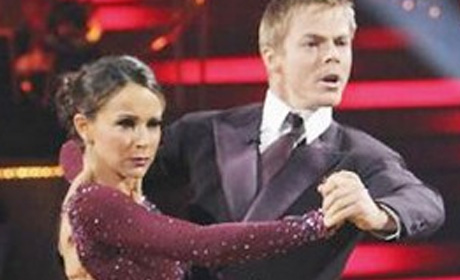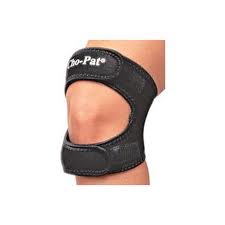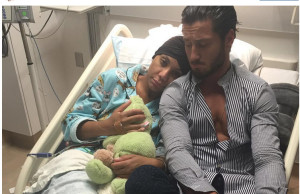Jennifer Grey gets first “Perfect Score” despite knee injury.

Actress Jennifer Grey posted this season of Dancing with the Stars’ first “perfect score” for her rumba with dance partner Derek Hough last night. At the end of the show, the 52 year old actress was tied at the top of the Leader Board with singer Brandi. This was done despite the fact that Grey has been dancing with pain in her knee caused by a patella tendinitis. Rehearsal clips from earlier in the week showed Grey being barely able to dance, then being examined by orthopedic surgeon, Dr. Gary Brazina. According to Brazina: “You’ve got this partial tearing of the tendon constantly…She has a fairly significant patella tendinitis. It’s inflamed, it’s badly inflamed.” When Grey had to decide whether to continue in the DWTS competition, she called in her father, Caberet actor, Joel Grey to talk it over with him. “My dad reminded me of who I am… My knee hurts but I’m going to push through, because my dad always told me ‘The show must go on’.” And so she did…
Tendinitis is a common condition that involve inflammation of the soft tissue around muscles and bones, most often in the shoulder, elbow, wrist, hip, knee, or ankle. A tendon is a flexible band of fibrous tissue that connects muscles to bones. Tendons transmit the pull of the muscle to the bone to cause movement. They are found throughout the body, including the hands, wrists, elbows, shoulders, hips, knees, ankles, and feet. Tendons can be small, like those found in the hand, or large, like the Achilles tendon in the heel. Tendinitis is an inflammation of a tendon.
What Causes Tendinitis?
Tendinitis is most often the result of a repetitive injury in the affected area. These conditions occur more often with age. Tendons become less flexible with age, and therefore, more prone to injury. People such as carpenters, gardeners, musicians, and athletes who perform activities that require repetitive motions or place stress on joints are at higher risk for tendinitis .
 The patella tendon is the band of tissue that connects the knee cap (the patella) to the larger of the two lower leg bones called the tibia. Along with the quadriceps muscle and the quadriceps tendon, these structures allow your knee to extend, or straighten out the leg.
The patella tendon is the band of tissue that connects the knee cap (the patella) to the larger of the two lower leg bones called the tibia. Along with the quadriceps muscle and the quadriceps tendon, these structures allow your knee to extend, or straighten out the leg.
Patella tendinitis is also due to overuse, especially from jumping activities. If a person overuses a tendon during activities such as dancing, cycling, or running, it may elongate or undergo microscopic tears and become inflamed. Trying to break a fall may also cause the quadriceps muscles to contract and tear the quadriceps tendon above the knee cap (patella) or the patellar tendon below it. This type of injury is most likely to happen in older people whose tendons tend to be weaker and less flexible. Tendinitis of the patellar tendon is sometimes called jumper’s knee because in sports that require jumping, such as basketball, the muscle contraction and force of hitting the ground after a jump strain the tendon. After repeated stress, the tendon may become inflamed or tear.
People with tendinitis of the knee may feel pain during running, hurried walking, or jumping. Knee tendinitis can increase risk for ruptures or large tears to the tendon. A complete rupture of the quadriceps or patellar tendon is not only painful, but also makes it difficult for a person to bend, extend, or lift the leg; or to bear weight on the involved leg.
How is Tendinitis treated?
Treatment focuses on healing the injured tendon. The first step in treating this condition is to reduce pain and inflammation with rest, compression, elevation, and anti-inflammatory medicines such as aspirin, naproxen (Naprosyn1, Aleve), or ibuprofen (Advil, Motrin, or Nuprin).
 Activity involving the affected joint is also restricted to encourage healing and prevent further injury. In some cases a physician may recommend a support strap (called an infrapatellar strap or a Chopat strap), a knee brace, or custom orthotics to provide some pain relief, limiting the pull of the tendon on the bone.
Activity involving the affected joint is also restricted to encourage healing and prevent further injury. In some cases a physician may recommend a support strap (called an infrapatellar strap or a Chopat strap), a knee brace, or custom orthotics to provide some pain relief, limiting the pull of the tendon on the bone.
The doctor or therapist may use ultrasound (gentle sound-wave vibrations) to warm deep tissues and improve blood flow. Iontophoresis may also be used. This involves using an electrical current to push a corticosteroid medication through the skin directly over the inflamed tendon.
Gentle stretching and strengthening exercises are added gradually. Massage of the soft tissue may be helpful. These may be preceded or followed by use of an ice pack. The type of exercises recommended may vary depending on the location of the affected tendon.
If there is no improvement, the doctor may inject a corticosteroid medicine into the area surrounding the inflamed tendon. While corticosteroid injections are a common treatment, they must be used with caution because they may lead to weakening or rupture of the tendon (especially weight-bearing tendons such as the Achilles [ankle], posterior tibial [arch of the foot], and patellar [knee] tendons). If there is still no improvement after 6-12 months, the doctor may perform either arthroscopic or open surgery to repair damage and relieve pressure on the tendons.
For more information about patella tendinitis, click here to go to the Resounding Health Casebook on the topic.



























0 comments